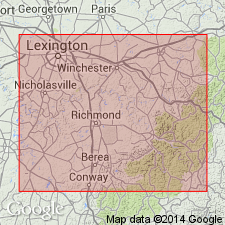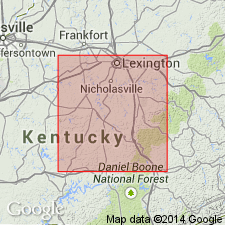
- Usage in publication:
-
- Kiddville bed
- Modifications:
-
- Named
- Dominant lithology:
-
- Limestone
- AAPG geologic province:
-
- Cincinnati arch
Summary:
Pg. 92, 93. Kiddville bed or Kiddville layer. Dense light-gray limestone, blue argillaceous gritty limestone, and reddish-brown limestone. Thickness 0 to 3 feet. Characterized by fish remains. Bottom layer of Boyle limestone (Devonian). Overlies Crab Orchard formation (Silurian). Age is Middle Devonian.
Named for small hamlet 1 mi north of Indian Fields, Clark Co., east-central KY.
Source: US geologic names lexicon (USGS Bull. 896, p. 1092).

- Usage in publication:
-
- Kiddville Formation
- Modifications:
-
- Revised
- AAPG geologic province:
-
- Cincinnati arch
Summary:
Kiddville Bed of Boyle Dolomite here referred to as a Formation in Boyle Group. Consists of tan to brown dolomite, conglomerate, and bone bed. 4.15 ft thick at type locality, of which 3.4 ft is bone bed. Maximum thickness 6.6 ft. Overlies Crab Orchard Shale. Age is Middle Devonian.
Source: GNU records (USGS DDS-6; Reston GNULEX).
For more information, please contact Nancy Stamm, Geologic Names Committee Secretary.
Asterisk (*) indicates published by U.S. Geological Survey authors.
"No current usage" (†) implies that a name has been abandoned or has fallen into disuse. Former usage and, if known, replacement name given in parentheses ( ).
Slash (/) indicates name conflicts with nomenclatural guidelines (CSN, 1933; ACSN, 1961, 1970; NACSN, 1983, 2005, 2021). May be explained within brackets ([ ]).

